Comprehensive Guide to Reverse Charge under GST(Pre-order Book Launch)
by Dhruv Dedhia, Vinay Kumar J, Rajesh MaddiCONTENTS
Chapter 1— Reverse Charge under GST – An Introduction
| 1.1 What is Reverse Charge Mechanism? | 1 |
| 1.2 Need for Reverse Charge Mechanism | 1 |
| 1.3 A wrong step towards the Reverse Charge | 2 |
| 1.4 Reintroducing the Reverse Charge Properly | 3 |
| 1.5 A Paramount Implementation of Reverse Charge: | 5 |
| 1.6 Revamping the Reverse Charge in GST | 6 |
| 1.7 Advantages of Reverse Charge | 6 |
| 1.8 Types of Levies under Indirect Taxes | 7 |
|
7 |
|
8 |
|
8 |
|
8 |
| 1.9 Sections 9(3) vs 9(4) vs 9(5) | 8 |
| 1.10 Concept of Composite Supplies & Mixed Supplies | 9 |
|
9 |
|
11 |
| 1.11 RCM Supplies made to SEZ Unit or SEZ Developer | 11 |
| 1.12 Transitional Provisions | 13 |
| 1.13 Exemptions under GST – Whether applicable to Recipient?. | 13 |
| 1.14 Supplier deposits the GST on supplies taxable under RCM | 14 |
| 1.15 Reverse Charge for Casual Taxable Persons | 14 |
Chapter 2— Time of Supply for Services under Reverse Charge
| 2.1 Introduction | 16 |
| 2.2 Point of taxation under Erstwhile Regime | 16 |
| 2.3 Time of Supply in GST | 17 |
| 2.4 Issuance of invoice for time of supply. | 19 |
| 2.5 Timeline for issuance of invoice | 19 |
| 2.6 Date of payment for time of supply | 20 |
| 2.7 Associated Enterprises | 20 |
| 2.8 Provision of service – Time of Supply? | 22 |
| 2.9 Residual Time of Supply | 23 |
| 2.10 Conclusion | 24 |
Chapter 3— List of Goods and Services under RCM in GST
| 3.1 Extract of Notification No. 13/2017 – CT (Rate) as amended from time to time | 25 |
| 3.2 Extract of Notification No. 07/2019 – CT (Rate) as amended from time to time | 36 |
| 3.3 Extract of Notification No. 04/2017 – CT (Rate) as amended from time to time | 37 |
| 3.4 List of Services covered under Reverse Charge under Service Tax Regime (Extract of Notification No. 30/2012 – Service Tax as amended from time to time) | 39 |
Chapter 4— Goods Transport Agency Services
| 4.1 Introduction | 44 |
| 4.2 Under Earlier Regime | 44 |
| 4.3 Entry under GST Regime (w.e.f. 01st July, 2017) | 45 |
| 4.4 Exemptions | 47 |
| 4.5 Analysis of Service | 48 |
|
48 |
|
49 |
|
50 |
|
51 |
| 4.6 Supplier of service | 53 |
| 4.7 Recipient of Service | 56 |
|
56 |
|
57 |
|
61 |
| 4.8 Exemptions for GTA | 64 |
|
64 |
|
65 |
|
65 |
|
67 |
|
67 |
|
69 |
| 4.9 Valuation | 69 |
|
69 |
|
70 |
| 4.10 Flow Chart | 70 |
| 4.11 Place of Supply | 70 |
| 4.12 Some Important Aspects | 72 |
|
72 |
| 4.13 Issues and Solutions | 72 |
| 4.14 Judicial Pronouncements | 74 |
Chapter 5— Legal Services by an Advocate
| 5.1 Introduction | 78 |
| 5.2 Under Earlier Regime | 78 |
| 5.3 Entry under GST Regime (w.e.f. 01st July, 2017) | 80 |
| 5.4 Exemptions | 81 |
| 5.5 Analysis of Service | 81 |
|
82 |
|
82 |
|
82 |
|
83 |
|
83 |
|
85 |
|
86 |
|
87 |
|
87 |
|
87 |
|
88 |
|
89 |
| 5.6 Flow chart | 90 |
| 5.7 Valuation | 90 |
| 5.8 Place of Supply | 91 |
| 5.9 Judicial Pronouncements | 91 |
| 5.10 FAQs Answered | 92 |
Chapter 6— Arbitral Tribunal Services
| 6.1 Introduction | 94 |
| 6.2 Under Earlier Regime | 94 |
| 6.3 Entry under GST Regime (w.e.f. 01st July, 2017) | 94 |
| 6.4 Exemptions | 95 |
| 6.5 Analysis of Service | 95 |
|
95 |
|
97 |
|
97 |
| 6.6 Flow Chart | 98 |
| 6.7 Valuation | 99 |
| 6.8 Place of Supply | 99 |
| 6.9 FAQs Answered | 99 |
Chapter 7— Sponsorship Services
| 7.1 Introduction | 100 |
| 7.2 Under Earlier Regime | 100 |
| 7.3 Entry under GST Regime (w.e.f. 01st July, 2017) | 101 |
| 7.4 Exemptions | 102 |
| 7.5 Analysis of Service | 102 |
|
102 |
|
103 |
|
104 |
| 7.6 Supplier of Service | 105 |
| 7.7 Recipient of Service | 106 |
|
106 |
|
107 |
| 7.8 Valuation | 107 |
| 7.9 Place of Supply | 108 |
| 7.10 Judicial Pronouncements | 109 |
| 7.11 FAQs Answered | 109 |
Chapter 8— Government Services
| 8.1 Introduction | 111 |
| 8.2 Under Earlier Regime | 111 |
| 8.3 Entry under GST Regime (w.e.f. 01st July, 2017) | 112 |
| 8.4 Exemptions | 113 |
| 8.5 Analysis of Service | 115 |
|
115 |
|
115 |
|
116 |
|
117 |
|
118 |
|
119 |
|
121 |
|
122 |
| 8.6 Supplier of Service | 123 |
|
123 |
|
124 |
|
125 |
|
125 |
| 8.7 Exemption to Suppliers engaged exclusively in making Exempt Supplies | 126 |
| 8.8 Flow Chart | 127 |
| 8.9 Sovereign Functions | 127 |
|
128 |
|
128 |
|
130 |
| 8.10 Tax on Royalty – Tax or Tax on Tax? | 131 |
|
131 |
|
133 |
|
133 |
|
134 |
| 8.11 Valuation | 134 |
| 8.12 Place of Supply | 135 |
| 8.13 Judicial Pronouncements | 135 |
| 8.14 Advance Rulings | 136 |
Chapter 9— Renting of Immovable Property by the Government
| 9.1 Introduction | 139 |
| 9.2 Under Earlier Regime | 139 |
| 9.3 Entry under GST Regime (w.e.f. 01st Feb, 2018) | 141 |
| 9.4 Exemption | 142 |
| 9.5 Analysis of Service | 142 |
|
143 |
|
145 |
|
145 |
|
146 |
|
147 |
|
147 |
|
|
|
149 |
|
149 |
|
149 |
|
150 |
| 9.6 Flow Chart | 151 |
| 9.7 Valuation | 151 |
|
151 |
|
152 |
| 9.8 Place of Supply | 152 |
| 9.9 Judicial Pronouncements | 153 |
| 9.10 Advance Rulings | 154 |
| 9.11 FAQs Answered | 155 |
Chapter 10— Transfer of Development Rights or Floor Space Index
| 10.1 Introduction | 156 |
| 10.2 Under Service Tax Regime | 156 |
| 10.3 GST Implications Prior to 01.04.2019 | 157 |
| 10.4 Under GST Regime (w.e.f. 01st April, 2019) | 158 |
| 10.5 Exemptions | 158 |
| 10.6 Analysis of Service | 159 |
|
159 |
|
159 |
|
160 |
|
161 |
|
161 |
|
162 |
|
163 |
|
164 |
| 10.7 Supplier of Service | 166 |
| 10.8 Recipient of Service | 166 |
| 10.9 Valuation | 167 |
| 10.10 Place of Supply | 168 |
| 10.11 Time of Supply | 169 |
| 10.12 ITC Eligibility of Tax paid under RCM | 170 |
Chapter 11— Long-Term Lease of Land
| 11.1 Introduction | 171 |
| 11.2 Under Earlier Regime | 171 |
| 11.3 Entry under GST Regime | 172 |
| 11.4 Exemptions | 172 |
| 11.5 Analysis of Service | 173 |
|
174 |
|
175 |
|
176 |
|
177 |
|
178 |
| 11.6 Supplier of Service | 178 |
| 11.7 Recipient of Servic | 179 |
| 11.8 Valuation | 180 |
| 11.9 Place of Supply | 180 |
Chapter 12— Director Services
| 12.1 Introduction | 182 |
| 12.2 Under Earlier Regime | 182 |
| 12.3 Entry under GST Regime | 183 |
| 12.4 Analysis of Service | 183 |
|
183 |
|
184 |
|
184 |
|
185 |
|
185 |
|
186 |
|
187 |
|
187 |
|
188 |
| 12.5 Flow Chart | 189 |
| 12.6 Valuation | 189 |
|
190 |
| 12.7 Place of Supply | 190 |
| 12.8 Judicial Pronouncements | 191 |
| 12.9 FAQs Answered | 191 |
Chapter 13— Supply of Security Personnel
| 13.1 Introduction | 193 |
| 13.2 Under Earlier Regime | 193 |
| 13.3 Entry under GST Regime (w.e.f. 01st January, 2019) | 194 |
| 13.4 Exemptions | 194 |
| 13.5 Analysis of Service | 195 |
|
195 |
| 13.6 Supplier of Service | 196 |
| 13.7 Recipient of Service | 197 |
|
198 |
|
200 |
|
200 |
| 13.8 Flow chart | 200 |
| 13.9 Valuation | 200 |
|
201 |
|
202 |
| 13.10 Place of Supply | 203 |
| 13.11 Judicial Pronouncements | 205 |
| 13.12 Advance Rulings | 206 |
| 13.13 FAQs Answered | 206 |
Chapter 14— Renting of Motor Vehicle
| 14.1 Introduction | 209 |
| 14.2 Under Earlier Regime | 209 |
| 14.3 Exemptions | 210 |
| 14.4 Analysis of Service | 211 |
|
211 |
|
212 |
|
213 |
|
214 |
|
215 |
| 14.5 Supplier of service | 217 |
| 14.6 Recipient of Service | 218 |
| 14.7 Important Aspects | 220 |
|
220 |
|
221 |
|
222 |
| 14.8 Exemption Analysis | 222 |
|
222 |
|
223 |
|
224 |
| 14.9 Flow Chart | 224 |
| 14.10 Valuation | 225 |
| 14.11 Place of Supply | 225 |
| 14.12 Advance Rulings | 226 |
| 14.13 FAQs Answered | 226 |
Chapter 15— GST on Import of Services
| 15.1 Introduction | 228 |
| 15.2 Under Earlier Regime | 228 |
| 15.3 Entry under GST Regime (w.e.f. 01st July, 2017) | 229 |
| 15.4 Exemptions | 229 |
| 15.5 Analysis of Service | 230 |
|
230 |
|
232 |
|
233 |
|
.235 |
|
236 |
| 15.6 Supplier of Service | 236 |
| 15.7 Recipient of Service | 237 |
| 15.8 Analysis of Exemptions | 237 |
|
238 |
|
238 |
|
239 |
| 15.9 Valuation | 239 |
| 15.10 An Insight on Different Services | 241 |
|
241 |
|
241 |
|
242 |
|
242 |
|
243 |
|
244 |
|
245 |
|
245 |
|
246 |
|
246 |
|
247 |
|
248 |
| 15.11 Online Information Database Access or Retrieval Services | 248 |
|
248 |
|
250 |
|
251 |
| 15.12 FAQs Answered | 251 |
| 15.13 Conclusion | 252 |
Chapter 16— Transportation of Goods by Vessel – Ocean Freight
| 16.1 Introduction | 253 |
| 16.2 Under Earlier Regime | 253 |
| 16.3 Entry under GST Regime (w.e.f. 01st July, 2017) | 255 |
| 16.4 Exemptions | 255 |
| 16.5 Analysis of Service | 255 |
|
256 |
|
256 |
|
259 |
|
259 |
|
259 |
|
260 |
|
260 |
|
260 |
| 16.6 Supplier of Service | 261 |
| 16.7 Recipient of Service | 262 |
| 16.8 Flow Chart | 263 |
| 16.9 Valuation | 263 |
| 16.10 Place of Supply | 264 |
Chapter 17— Renting of Residential Dwelling Services
| 17.1 Introduction | 266 |
| 17.2 Under Earlier Regime | 266 |
| 17.3 Entry under GST Regime (w.e.f. 18th July, 2022) | 267 |
| 17.4 Exemptions | 267 |
| 17.5 Analysis of Service | 267 |
|
268 |
|
268 |
|
269 |
|
270 |
|
270 |
| 17.6 Supplier of Service | 271 |
| 17.7 Recipient of Service | 271 |
| 17.8 Flow Chart | 272 |
| 17.9 Valuation | 272 |
| 17.10 Place of Supply | 272 |
| 17.11 FAQs Answered | 273 |
Chapter 18— Insurance Agent Services
| 18.1 Introduction | 276 |
| 18.2 Under Earlier Regime | 277 |
| 18.3 Entry under GST Regime (w.e.f. 01st July, 2017) | 278 |
| 18.4 Analysis of Service | 278 |
|
278 |
|
|
| 18.5 Supplier of Service | 281 |
|
281 |
| 18.6 Recipient of Service | 282 |
| 18.7 Valuation | 282 |
|
283 |
| 18.8 Place of Supply | 283 |
| 18.9 Judicial Pronouncements | 284 |
| 18.10 FAQs Answered | 285 |
Chapter 19— Recovery Agent Services
| 19.1 Introduction | 286 |
| 19.2 Under Earlier Regime | 286 |
| 19.3 Entry under GST Regime (w.e.f. 01st July, 2017) | 287 |
| 19.4 Analysis of Service | 287 |
|
287 |
|
288 |
|
288 |
|
289 |
|
290 |
|
290 |
| 19.5 Valuation | 290 |
| 19.6 Place of Supply | 290 |
| 19.7 Judicial Pronouncements | 291 |
| 19.8 FAQs Answered | 291 |
Chapter 20— Transfer or Permitting Use of Copyright
| 20.1 Introduction | 293 |
| 20.2 Under Earlier Regime | 293 |
| 20.3 Entry under GST Regime (w.e.f. 01st July, 2017) | 295 |
| 20.4 Analysis of Service | 295 |
|
295 |
|
296 |
|
296 |
|
297 |
|
298 |
|
.299 |
|
300 |
|
300 |
|
301 |
|
302 |
|
302 |
| 20.5 Supplier of Service | 303 |
| 20.6 Recipient of Service | 304 |
| 20.7 Valuation | 304 |
| 20.8 Place of Supply | 304 |
| 20.9 Conclusion | 305 |
| 20.10 FAQ’s Answered | 305 |
Chapter 21— Services of an Author
| 21.1 Introduction | 307 |
| 21.2 Under Earlier Regime | 307 |
| 21.3 Entry under GST Regime (Till 30th September, 2019) | 308 |
| 21.4 Entry under GST Regime (w.e.f. 01st October, 2019) | 308 |
| 21.5 Analysis of Service | 309 |
|
309 |
|
310 |
|
311 |
|
312 |
|
313 |
|
313 |
|
314 |
|
315 |
|
315 |
|
316 |
| 21.6 Valuation | 317 |
| 21.7 Place of Supply | 317 |
| 21.8 Conclusion | 318 |
| 21.9 FAQs Answered | 318 |
Chapter 22— Overseeing Committee Services
| 22.1 Introduction | 322 |
| 22.2 Entry under GST Regime (w.e.f. 13th October, 2017) | 322 |
| 22.3 Analysis of Service | 322 |
|
323 |
|
323 |
|
324 |
|
324 |
| 22.4 Valuation | 325 |
| 22.5 Place of Supply | 325 |
Chapter 23— Direct Selling Agent Services
| 23.1 Introduction | 327 |
| 23.2 Under Earlier Regime | 327 |
| 23.3 Entry under GST Regime (w.e.f. 27th July, 2018) | 327 |
| 23.4 Analysis of Service | 328 |
|
328 |
|
328 |
|
329 |
|
329 |
| 23.5 Valuation | 329 |
| 23.6 Place of Supply & Type of Tax | 330 |
| 23.7 FAQs Answered | 331 |
Chapter 24— Business Facilitator Services
| 24.1 Introduction | 333 |
| 24.2 Under Earlier Regime | 333 |
| 24.3 Entry under GST Regime (w.e.f. 01st January, 2019) | 334 |
| 24.4 Exemptions | 334 |
| 24.5 Analysis of Service | 334 |
|
334 |
|
335 |
|
335 |
|
336 |
|
336 |
|
336 |
|
337 |
| 24.6 Services provided to Insurance Company | 337 |
| 24.7 Flowchart | 338 |
| 24.8 Valuation | 338 |
| 24.9 Place of Supply | 338 |
Chapter 25— Business Correspondent Agent Services
| 25.1 Introduction | 340 |
| 25.2 Under Earlier Regime | 340 |
| 25.3 Entry under GST Regime (w.e.f. 01st January, 2019) | 341 |
| 25.4 Exemptions | 341 |
| 25.5 Analysis | 341 |
|
342 |
|
342 |
|
343 |
|
343 |
|
343 |
|
344 |
|
344 |
|
344 |
| 25.6 Flow Chart | 345 |
| 25.7 Valuation | 345 |
| 25.8 Place of Supply | 345 |
Chapter 26— Lending of Securities
| 26.1 Introduction | 347 |
| 26.2 Entry under GST Regime (w.e.f. 01st October, 2019) | 347 |
| 26.3 Analysis of Service | 348 |
|
348 |
|
349 |
|
349 |
|
350 |
| 26.4 Supplier of Service | 351 |
| 26.5 Recipient of Service | 351 |
| 26.6 Flow Chart | 352 |
| 26.7 Place of Supply | 352 |
Chapter 27— Reverse Charge on Goods
| 27.1 Introduction | 354 |
| 27.2 Under Earlier Regime | 354 |
| 27.3 Entries under GST | 354 |
| 27.4 Exemptions under Notification No. 02/2017 – CT (Rate) | 356 |
| 27.5 Analysis | 356 |
|
357 |
|
357 |
|
358 |
|
359 |
|
361 |
|
362 |
|
363 |
|
363 |
|
363 |
|
365 |
|
367 |
|
368 |
|
368 |
|
369 |
|
370 |
|
371 |
|
371 |
|
372 |
|
373 |
|
375 |
| 27.6 Valuation | 375 |
| 27.7 Time of Supply | 376 |
|
376 |
| 27.8 Place of Supply | 377 |
|
378 |
|
379 |
| 27.9 Advance Rulings | 380 |
Chapter 28— Procurement from Unregistered Suppliers
| 28.1 Introduction | 381 |
| 28.2 Under Earlier Regime | 381 |
| 28.3 A Brief Background under GST | 382 |
|
382 |
|
388 |
| 28.4 Entry under Notification No. 07/2019 – CT (Rate) (w.e.f. 01st April, 2019) | 389 |
| 28.5 Analysis of Supplies | 390 |
|
390 |
|
394 |
|
395 |
| 28.6 Valuation | 395 |
| 28.7 Place of Supply | 395 |
| 28.8 FAQs Answered | 397 |
| Annexure-1: A Brief on Types of Real Estate Projects | 398 |
Chapter 29— Compulsory Registration – Whom does it Impact?
| 29.1 Introduction . | 401 |
| 29.2 Advantages of Registration | 401 |
| 29.3 Registration Under GST | 402 |
| 29.4 Compulsory Registration under GST | 403 |
| 29.5 Compulsory Registration for an Individual | 403 |
| 29.6 Compulsory Registration for Unregistered Small Business | 405 |
| 29.7 Registration effect on Supplier suppling RCM supplies | 406 |
| 29.8 Recipient engaged in making only Exempt Supplies | 406 |
| 29.9 Supplier engaged in RCM Supplies & FCM Supplies | 407 |
Chapter 30— Input Tax Credit
| 30.1 A brief History on ITC | 408 |
| 30.2 What is ITC? | 408 |
| 30.3 Eligibility for claiming ITC | 409 |
| 30.4 General conditions for claiming ITC | 409 |
| 30.5 Analysis of Condition of Claiming ITC under RCM | 410 |
| 30.6 Blocked ITC | 413 |
|
413 |
|
415 |
|
415 |
|
415 |
|
|
|
416 |
|
418 |
| 30.7 Rules 42 & 43 Reversal – Relevant for Supplier | 419 |
| 30.8 Revenue Neutrality | 420 |
| 30.9 Some Issues under ITC | 421 |
|
421 |
|
421 |
Chapter 31— Procedural Aspects of Reverse Charge
| 31.1 Documentation for Recipient | 423 |
|
423 |
|
424 |
|
425 |
| 31.2 Documentation for Supplier | 425 |
|
425 |
|
426 |
| 31.3 Payment of Taxes | 426 |
|
427 |
|
427 |
| 31.4 Interest of delayed payment of taxes | 428 |
| 31.5 GST Returns | 429 |
|
429 |
|
430 |
| Chapter 32— Bibliography | 431 |
About the Author
Have Questions About This Book?
Our course advisors are here to help you make the right decision for your career growth.
Other books
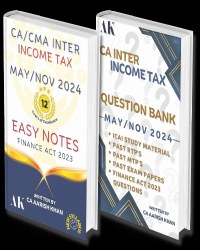
CA/CMA INTER COMBO - COLOURED EASY NOTES + QUESTION BANK
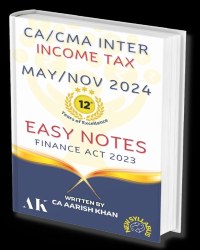
CA/CMA INTER EASY NOTES COLOURED
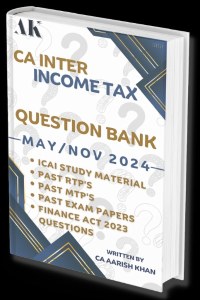
CA/CMA INTER INCOME TAX QUESTION BANK

GST (IDT) Book - 4th Edition | May, Sept 2026 & Jan 2027 Attempt
List your Books
Share your knowledge and help shape the next generation of tech-savvy CA & Tax professionals while building a rewarding career in education.
Get Started

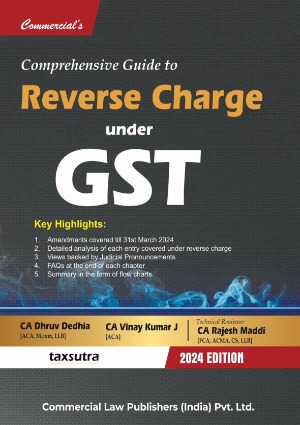
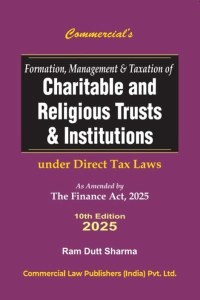
 CAclubindia
CAclubindia
